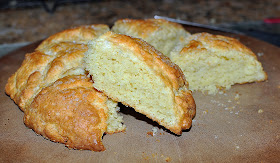According to the US Department of State (as of April 16, 2016), there are 205 recognized countries on Earth. Alphabetically, Afghanistan is the first on the list and Zimbabwe is last; with 203 other places sandwiched in between. That is a lot of territory to cover, so lets start baking. I'm not going in an particular order and I just want to bounce around the list as an interesting recipe catches my eye.
First to be baked on my One Earth, One Oven - A World-Wide Baking Adventure is the:
Argentinian Alfajores
Now what is an Alfajores? Well, after baking it I can tell you it is something like a very tender, shortbread or sugar cookie that is slathered with dulce de leche and stacked to make a sandwich. The cookie part of the alfajores is soft and it little bit crumbly. It is tender and delicate, and simply melts in your mouth. The recipe I used also included lime zest so the cookie had a mild, citrus-y tang. And the dulce de leche filling --- Wow. Dulce de leche is similar in taste to soft caramel and it is pure heaven. Finally to complete the melody of flavors, the alfajores are rolled in sweetened coconut.
And the secret to the tender texture of the cookie, and what makes it different from shortbread or sugar or sandies, is a huge amount of cornstarch in the dough. Yep cornstarch. Now I've used cornstarch by the tablespoon before, but this recipe uses it by the cupful! The copious amount of cornstarch actually gives the cookie an odd kind of dry taste. It is not unpleasant, just different. And if the cookies are allowed to sit overnight, the cookie will start to draw moisture and flavors from the dulce de leche into the cookie itself.
So the cookie dough starts with sugar and soft butter that is cream till it is almost white in color (5-10 minutes), and then egg yolks, vanilla, and lime zest is added.
Next the mixture of flour, cornstarch, baking soda, and baking powder is added all at once. It will take 5-10 minutes for the ingredients to fully combine, so don't get discouraged and think that something is messed up. In the end the dough will look a little crumbly, but it will stick together when you roll it out.
Roll out the dough to 1/4 inch thickness. I split the dough into thirds and rolled it between two pieces of parchment paper. If you use the parchment paper you don't need to flour the surface to keep the dough from sticking. If you look closely at the picture below you will see the little flecks of lime zest.
Bake in a 325 degree oven for 12-14 minutes. Watch them closely and don't allow them to brown. The cookies don't spread much, so you can place them close together on the cookie sheet. Once they are cool, filling with the dulce de leche. You can make your own dulce de leche by simmering a can of sweetened condensed milk in a water bath for a few hours, but at Wally-World the can of Nestle la Lechera was just 50 cents more than a can of condensed milk so I just took the easy route.
I used a star tip to pipe the filling onto the cookies. As you can see I was pretty skimpy with the dulce de leche. Next time I will use LOTS more filling. The filling really makes the cookie.
And as a final step, the cookie is rolled in coconut.
I also rolled some in nuts and also dipped some in melted chocolate and then sprinkled with nuts and coconut. You can make these things as fancy or as plain as you want.
So what do you think of these Argentinian Alfajores?? Pretty sweet, huh? I think this baking adventure is going to be a lot of fun -- and a little fattening...
Happy Baking,
Carol
Argentinian Alfajores
(adapted from Cooking with Books)Ingredients
250 grams All-purpose Flour ( approximately 1-3/4 cups)
250 grams Cornstarch ( approximately 1-3/4 cups)
1/2 teaspoon Baking Soda
2 teaspoons Baking Powder
225 grams Unsalted Butter, softened ( 2 sticks)
150 grams granulated sugar (approximately 2/3 cup)
3 Large Egg Yolks
1 tablespoon Vanilla Extract
1 teaspoon Fresh Lime Zest
13 oz can Dulce de leche
1/2 cup Coconut, shredded
Directions
- Preheat oven to 325 degrees F.
- Sift together flour, cornstarch, baking soda, and baking powder. Set aside.
- Cream the softened butter and sugar until very pale in color (approximately 5 minutes).
- Add egg yolks, vanilla and line zest, to the butter/sugar and mix until combined.
- Add the dry ingredients all at once and mix until completely incorporated (5-10 minutes).
- Divide the dough into thirds, roll dough out to 1/4 inch thick, and then cut out using a circle cookie cutter.
- Place on a cookie sheet lined with parchment paper. The cookies don't spread very much so you can put them close together.
- Bake for 12-14 minutes. Don't let them brown.
- Transfer to a wire rack and cool completely before filling.
- Pipe the dulce de leche on the top of a cookie, and make sure you pipe close to the edge. Place a second cookie on top of the piped dulce de leche and gently press the two cookies together. You want the dulce de leche to squeeze slightly from between the cookies so the coconut can stick.
- Roll the cookie in shredded coconut allowing the coconut to stick to the exposed dulce de leche.
- Store in an airtight container.










